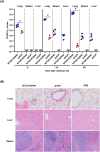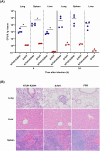RfaH contributes to maximal colonization and full virulence of hypervirulent Klebsiella pneumoniae
- PMID: 39364146
- PMCID: PMC11448354
- DOI: 10.3389/fcimb.2024.1454373
RfaH contributes to maximal colonization and full virulence of hypervirulent Klebsiella pneumoniae
Abstract
Hypervirulent K. pneumoniae (hvKp) have emerged as clinically important pathogens, posing a serious threat to human health. RfaH, a transcriptional elongation factor, has been regarded as implicated in facilitating the transcription of long virulence operons in certain bacterial species. In K. pneumoniae, RfaH plays a vital role in promoting CPS synthesis and hypermucoviscosity, as well as mediating bacterial fitness during lung infection. In this study, we aim to conduct a systematic investigation of the roles of rfaH in the survival, dissemination, and colonization of hvKp through in vitro and in vivo assays. We found that bacterial cells and colonies displayed capsule -deficient phenotypes subsequent to the deletion of rfaH in K. pneumoniae NTUH-K2044. We confirmed that rfaH is required for the synthesis of capsule and lipopolysaccharide (LPS) by positively regulating the expression of CPS and LPS gene clusters. We found that the ΔrfaH mutant led to a significantly decreased mortality of K. pneumoniae in a mouse intraperitoneal infection model. We further demonstrated that the absence of rfaH was associated with slower bacterial growth under conditions of low nutrition or iron limitation. ΔrfaH displayed reduced survival rates in the presence of human serum. Besides, the engulfment of the ΔrfaH mutant was significantly higher than that of NTUH-K2044 by macrophages in vivo, indicating an indispensable role of RfaH in the phagocytosis resistance of hvKp in mice. Both mouse intranasal and intraperitoneal infection models revealed a higher bacterial clearance rate of ΔrfaH in lungs, livers, and spleens of mice compared to its wild type, suggesting an important role of RfaH in the bacterial survival, dissemination, and colonization of hvKp in vivo. Histopathological results supported that RfaH contributes to the pathogenicity of hvKp in mice. In conclusion, our study demonstrates crucial roles of RfaH in the survival, colonization and full virulence of hvKp, which provides several implications for the development of RfaH as an antibacterial target.
Keywords: anti-phagocytosis; capsule; hypervirulent Klebsiella pneumoniae; rfaH; virulence.
Copyright © 2024 Qiu, Xiang, Yin, Fang, Dai, Zhang and Li.
Conflict of interest statement
The authors declare that the research was conducted in the absence of any commercial or financial relationships that could be construed as a potential conflict of interest.
Figures








Similar articles
-
Fumarate and nitrate reduction regulator (FNR) modulates hypermucoviscosity and virulence in hypervirulent Klebsiella pneumoniae through anaerobic adaptation.Virulence. 2025 Dec;16(1):2536186. doi: 10.1080/21505594.2025.2536186. Epub 2025 Jul 28. Virulence. 2025. PMID: 40720403 Free PMC article.
-
A Klebsiella pneumoniae Regulatory Mutant Has Reduced Capsule Expression but Retains Hypermucoviscosity.mBio. 2019 Mar 26;10(2):e00089-19. doi: 10.1128/mBio.00089-19. mBio. 2019. PMID: 30914502 Free PMC article.
-
Cell envelope defects of different capsule-null mutants in K1 hypervirulent Klebsiella pneumoniae can affect bacterial pathogenesis.Mol Microbiol. 2020 May;113(5):889-905. doi: 10.1111/mmi.14447. Epub 2020 Jan 20. Mol Microbiol. 2020. PMID: 31912541 Free PMC article.
-
The intersection of capsule gene expression, hypermucoviscosity and hypervirulence in Klebsiella pneumoniae.Curr Opin Microbiol. 2020 Apr;54:95-102. doi: 10.1016/j.mib.2020.01.006. Epub 2020 Feb 12. Curr Opin Microbiol. 2020. PMID: 32062153 Free PMC article. Review.
-
Klebsiella pneumoniae capsular polysaccharide: Mechanism in regulation of synthesis, virulence, and pathogenicity.Virulence. 2024 Dec;15(1):2439509. doi: 10.1080/21505594.2024.2439509. Epub 2024 Dec 13. Virulence. 2024. PMID: 39668724 Free PMC article. Review.
References
-
- Anes J., Dever K., Eshwar A., Nguyen S., Cao Y., Sivasankaran S. K., et al. . (2021). Analysis of the Oxidative Stress Regulon Identifies soxS as a Genetic Target for Resistance Reversal in Multidrug-Resistant Klebsiella pneumoniae . mBio 12, e0086721. doi: 10.1128/mBio.00867-21 - DOI - PMC - PubMed
-
- Ares M. A., Fernandez-Vazquez J. L., Rosales-Reyes R., Jarillo-Quijada M. D., von Bargen K., Torres J., et al. . (2016). H-NS nucleoid protein controls virulence features of klebsiella pneumoniae by regulating the expression of type 3 pili and the capsule polysaccharide. Front. Cell Infect. Microbiol. 6. doi: 10.3389/fcimb.2016.00013 - DOI - PMC - PubMed
MeSH terms
Substances
LinkOut - more resources
Full Text Sources

